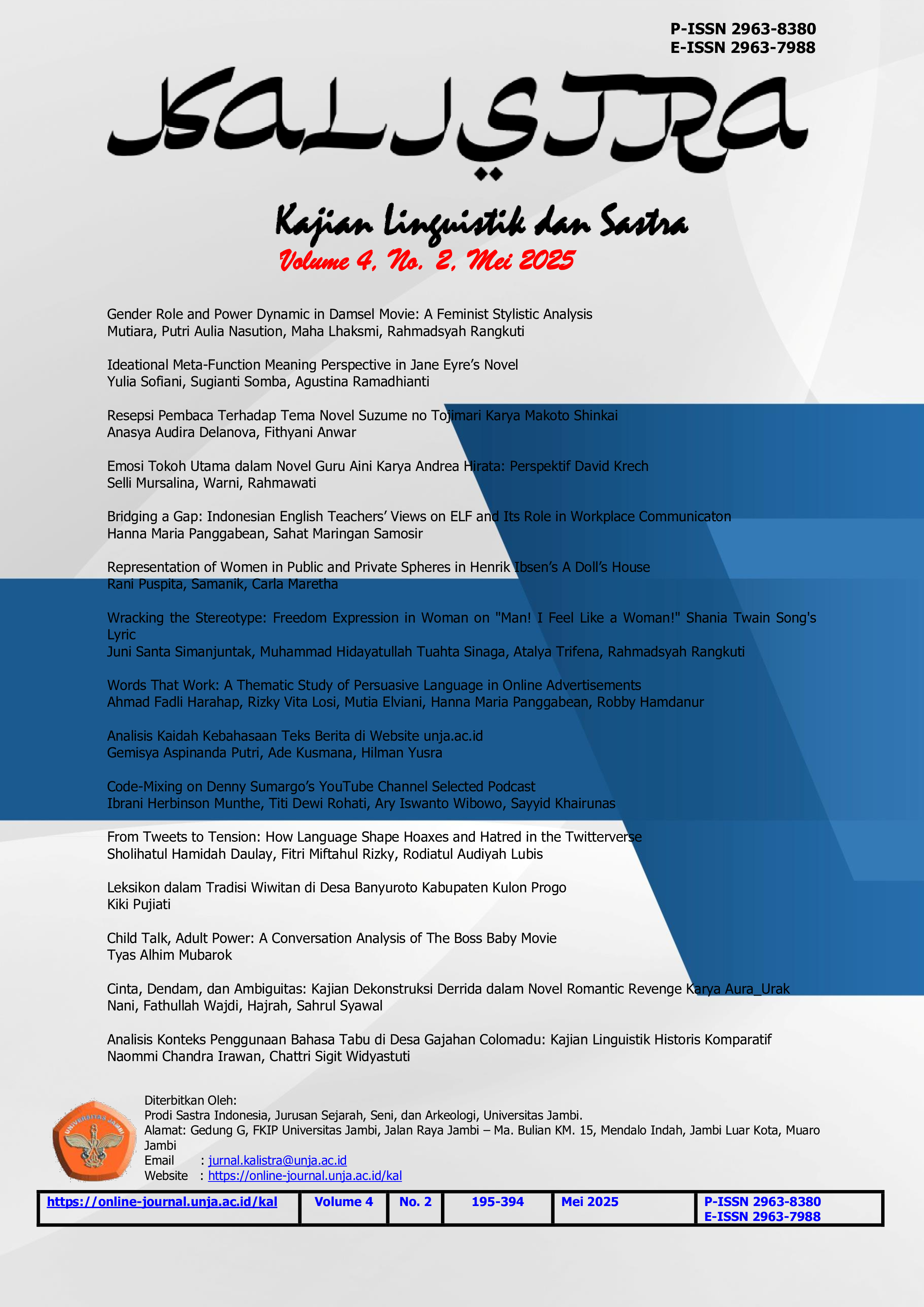Wracking the Stereotype: Freedom Expression in Woman on "Man! I Feel Like a Woman!" Shania Twain Song's Lyric
DOI:
https://doi.org/10.22437/kalistra.v4i2.42774Keywords:
Feminist stylistics, Stereotype, Women expression, WrackingAbstract
This study analyzes the song "Man! I Feel Like a Woman!" by Shania Twain using Sara Mills' feminist stylistic theory of three linguistic levels, namely words, phrases, and discourse to explore the lyrics that try to wrack various stereotypes attached to women, especially freedom of expression. This study uses a descriptive-qualitative method and explain the results on the word, sentence, and discourse level. Word-level analysis reveals generic pronouns and nouns emphasizing collective female identity. The phrase level reveals ready-made phrases, presuppositions and inferences, metaphors and transitive choices such as material, mental, relational, and existential that illustrate various aspects that wrack stereotypes against women. Discourse-level analysis reveals characterization, focalization, and schemata that provide deeper insight into the perspectives of the characters in the song. Overall, three-level analysis are in line with feminist principles, emphasizing to wracking stereotypes of freedom expression against women as the main theme.
Abstrak
Studi ini menganalisis lagu "Man! I Feel Like a Woman!" oleh Shania Twain menggunakan teori gaya feminis Sara Mills dari tiga tingkat linguistik, yaitu kata-kata, frasa, dan wacana untuk mengeksplorasi lirik yang mencoba merobek berbagai stereotip yang melekat pada perempuan, terutama kebebasan berekspresi. Penelitian ini menggunakan metode deskriptif-kualitatif dan menjelaskan hasilnya pada tingkat kata, kalimat, dan wacana. Analisis tingkat kata mengungkapkan kata ganti dan kata benda generik yang menekankan identitas perempuan kolektif. Tingkat frasa mengungkapkan frasa siap pakai, praanggapan dan kesimpulan, metafora dan pilihan transitif seperti material, mental, relasional, dan eksistensial yang menggambarkan berbagai aspek yang merusak stereotip terhadap perempuan. Analisis tingkat wacana mengungkapkan karakterisasi, fokalisasi, dan skema yang memberikan wawasan lebih dalam tentang perspektif karakter dalam lagu. Secara keseluruhan, analisis tiga tingkat sejalan dengan prinsip-prinsip feminis, menekankan pada stereotip kebebasan berekspresi terhadap perempuan sebagai tema utama.
Downloads
References
Almahameed, Y. S. (2020). A stylistic analysis of the short story "the little match girl”. International Journal of Innovation, Creativity and Change, 14(12), 1229–1240.
Apriliandra, S., & Krisnani, H. (2021). Perilaku diskriminatif pada perempuan akibat kuatnya budaya patriarki di indonesia ditinjau dari perspektif konflik. Jurnal Kolaborasi Resolusi Konflik, 3(1), 1–13. https://doi.org/10.24198/jkrk.v3i1.31968
Artanti, C., Zulaika, A. Y., & Rangkuti, R. (2023). Women Empowerment in Little Mix’s “Salute”: Feminist Stylistic Analysis. Titian: Jurnal Ilmu Humaniora, 07(02), 384–400. https://doi.org/https://online-journal.unja.ac.id/index.php/titian
Bhasin, K., & Khan, N. S. (n.d.). Persoalan pokok mengenai feminisme dan relevansinya. Gramedia Pustaka Utama.
Caroline, Y. P., Zahrani, T., Sitompul, M. R., & Rangkuti, R. (2023). A feminist-stylistic analysis of the taylor swift song entitled the man. KLAUSA (Kajian Linguistik, Pembelajaran Bahasa, Dan Sastra), 7(2), 115–124. https://doi.org/10.33479/klausa.v7i2.881
Gay, L. ., Mills, G. E., & Airasian, P. (2011). EDUCATIONAL RESEARCH Competencies for analysis and applications. In Sustainability (Switzerland) (10th ed., Vol. 11, Issue 1). Pearson Education. http://scioteca.caf.com/bitstream/handle/123456789/1091/RED2017-Eng-8ene.pdf?sequence=12&isAllowed=y%0Ahttp://dx.doi.org/10.1016/j.regsciurbeco.2008.06.005%0Ahttps://www.researchgate.net/publication/305320484_SISTEM_PEMBETUNGAN_TERPUSAT_STRATEGI_MELESTARI
Halliday, M., & Matthiessen, C. (2004). An introduction to functional grammar. Routledge. https://doi.org/https://doi.org/10.4324/9780203783771
Hussain, A. N., & Jabeen, T. (2019). A feminist stylistic analysis of “broken verses” by kamila shamsie. International Journal of English Linguistics, 9(6), 214–225. https://doi.org/10.5539/ijel.v9n6p214
Lakoff, G., & Johnson, M. (2008). Metaphors We Live By. University of Chicago Press.
Larasati, T. (2018). Stereotip terhadap perempuan pengemudi transportasi umum berbasis online di jakarta timur. Departemen Antropologi FISIP Universitas Airlangga, 1–11. https://repository.unair.ac.id/69511/
Li, M. . (2006). Functional Grammar: A Course Book. Foreign Languages Press.
Manurung, A. S. V., Perangin-angin, A. M. I., Tanjung, P. A. M., Hasanah, N., Marsha, S. A., & Rangkuti, R. (2023). Feminist stylistic analysis of ava max’s song “not your barbie girl.” Titian: Jurnal Ilmu Humaniora, 07(02), 401–414. https://doi.org/https://online-journal.unja.ac.id/index.php/titian
Mills, S. (1995a). Feminist stylistics. In Routledge. Taylor & Francis e-Library.
Mills, S. (1995b). Feminist Stylistics. Routledge.
Rosyidah, F. N., & Nurwati, N. (2019). Gender dan stereotipe: konstruksi realitas dalam media sosial instagram. Share : Social Work Journal, 9(1), 10–19. https://doi.org/10.24198/share.v9i1.19691
Simanjuntak, W. O., Saragih, S. E., Sihotang, T., & Rangkuti, R. (2024). A FEMINIST STYLISTIC ANALYSIS: WOMEN LEADERSHIP OF LITTLE MIX FEAT NICKI MINAJ’S LYRICS SONG WOMEN LIKE ME. JLL, 12(1), 77–90. https://doi.org/https://doi.org/10.35760/jll.2024.v12i1.9892
Downloads
Published
How to Cite
Issue
Section
License
Copyright (c) 2025 Juni Santa Simanjuntak, Muhammad Hidayatullah Tuahta Sinaga, Atalya Trifena, Rahmadsyah Rangkuti

This work is licensed under a Creative Commons Attribution-ShareAlike 4.0 International License.
Kalistra: Kajian Linguistik dan Sastra is licensed under Creative Commons Attribution-ShareAlike 4.0 International License.
Authors who publish their manuscripts in Kajian Linguistik dan Sastra agree to the following terms:
1. The copyright in each article belongs to the author.
2. The author acknowledges that Kajian Linguistik dan Sastra reserves the right to be the first to publish under a Creative Commons Attribution-ShareAlike 4.0 International License (Attribution 4.0 International CC BY-SA 4.0).
3. Authors may submit articles separately, arranging for non-exclusive distribution of manuscripts that have been published in this journal to other versions (e.g., delivery to the author's institutional repository, publication into a book, etc.), acknowledging that the manuscript has been first published in Kajian Linguistik dan Sastra.
















